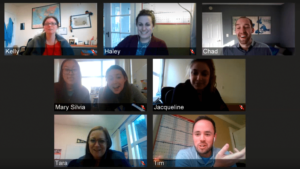Too many virtual meetings are broken. Need some virtual meeting ideas? Whether you are in a remote team or just meeting with clients once a month over Zoom, Google Hangouts, or phone, collaborating through pixels can be tough!
According to Gallup’s State of the American Workplace report, 43% of Americans said they spent at least some time working remotely last year. This is a giant flag waving that says to me, “there is a need for great resources on how to work remotely in a way that still fosters a sense of connection, belonging, and trust.” But, how? Let’s begin unpacking this huge topic by diving into how to lead better virtual meetings.
In the video above, I frame how we are asking the wrong question about virtual meetings and share a fun story connected to the chained up tricycle image above. And below, there are 3 ways you can enhance your virtual meetings.
3 Tips on How to Have Better Virtual Meetings
1.) Be Time Intentional with “Unofficial Starts”
The concept of the “unofficial start” was first given to me by Mark Collard and his book, Serious Fun. Basically the thought is that, in general, we wait for everyone to be present before we start. Some people show up early at 8:50am, others on time at 9:00am, and of course somebody who got caught behind a heard of chickens rolls in at 9:07am. In general, we reward the people who show up late by starting when they get there. Being intentional about creating an “unofficial start” that engages people before the official start time and runs into the first 5-10 minutes of the meeting can have a huge impact on engagement while also honoring peoples’ time. Virtually, this can also create really magical moments where connections can be built to foster that sense of “team.” But more often than not, we sit on mute with our cameras off until the minute it’s start time or idle chit chat to kill time until everybody is there.
My invitation to you: be ready with a prompt, question or call to action to kick things off with intention from the time the first person “dings” in. It might be, asking a question about the painting behind them, or asking people to Google an image representing something exciting they did last week and pasting it to the chat box. Or you could do make this simple question exercise virtual by sharing a picture of the cards. The key is knowing your audience, asking yourself, “how can I kick things off with purpose and intention?” And then taking the risk to actually lead that charge for everyone. Want suggestions specific to your group and context? I’m inviting you to personally email me at [email protected]. I may be a wee bit slow to respond, yet I do commit to getting back to you with some fresh ideas.
2.) Create “Connection before Content”
Do this. That’s it. Boom. Spending a few moments with connecting to each other, the purpose of the meeting, in a way that creates the opportunity for authenticity and vulnerability will transform your meetings. Much more importantly though, it will increase trust and engagement in the long term if you make a habit of doing connection before content at any meeting that is 60 minutes or more.
3.) Use “Pixel Magic”
“Chad, what do you mean? This sounds dumb.” Hear me out. I believe that there are actual several ways that virtual meetings have the potential to be more effective than face-to-face meetings. When we are in person with each other, we rarely have the ability to seamlessly screen share, type into a chat box all at the same time, or share links/videos instantaneously (i.e., “Pixel Magic”). Rather than trying to replicate the face-to-face human experience over a video chat, use the technology made available to you.
Here is one crystal clear example on how to avoid group think that I use when I’m working virtually with a client to plan a workshop or conference.
Once, while working with a medium-sized organization, I was in a meeting on Zoom meeting with 7 other people (see snapshot below). We were in a period of brainstorming and I had everyone use the chat box to type a list of ideas they had on the topic before anybody else even shared. Classic way to avoid groupthink: brainstorm alone first and together second. Then, “3…2…1…” I counted down and invited everybody to press “enter” and send their ideas all at the same time. Then we spend the next 2-3 minutes reading everybody else’s responses. Combined ideas. Iterated and added to other. And started to gain consensus on what direction we would move toward.

This very simple process would have taken a solid hour in person. Virtually, it took 15 minutes. This is just one example of how I believe we can work better together remotely. Does working remotely have it’s challenges? You bet! Bad wifi, terrible audio quality, no feel, smell, or touch, etc. But if you want to create a culture of flexibility for your employees, working virtually is a must! So let’s make it awesome!